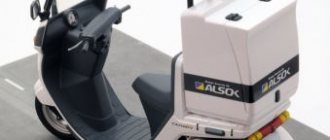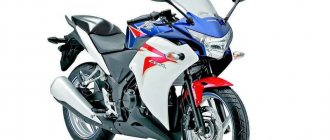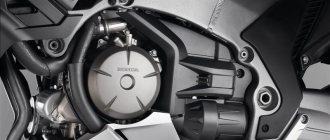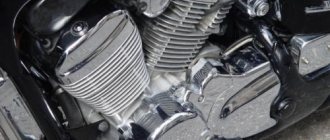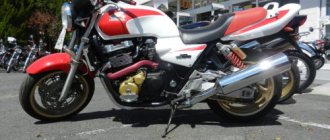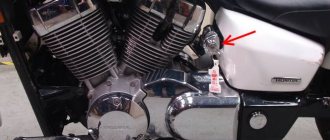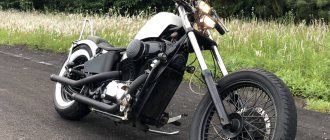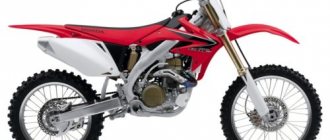VTR 1000 F
- Honda motorcycle model
The Honda VTR1000F sports motorcycle model was introduced in 1997 for the markets of Japan, Australia and Europe. The model also had the Firestorm prefix, but in the North American market it was called differently - Superhawk.
The appearance of the VTR1000 was due to Honda's desire to create a full-fledged sports motorcycle that corresponds to European concepts and ideas about motorcycle construction - in particular, the flagship models of Ducati and Moto Guzzi. The engine from the VT1100 was used as a prototype engine in the early stages of development (1986), but the project was subsequently frozen. They returned to it only in 1994, having seriously revised the configuration of everything - from the design, chassis to the engine.
The model was based on a 2-cylinder V-shaped liquid-cooled engine with a volume of about 1000 cm³, producing up to 110 hp. power and up to 97 Nm of torque. This engine was subsequently used on the model - Honda Varadero 1000.
In 2000, the VTR1000 line was replenished with a new modification, called the Honda VTR1000 SP-1. In the North American market, the model was sold under the name Honda RVT1000R. The model is also known as RC51. The modification was a replica of a racing motorcycle, homologated for public roads. This version was not available in Japan and was only sold in export markets - Europe, North America, Australia.
The Honda VTR1000 SP-1 modification was very different from the basic version of the VTR1000F - a new appearance, fully adjustable suspension, electronic fuel injection instead of carburetors, an increased diameter of the front brake discs, a different engine configuration - improved performance, timing gear drive (instead of a chain on the VTR1000F), changed gear ratios in the gearbox.
In 2002, the modification received some changes and changed its name - Honda VTR1000 SP-2. The changes affected the injection system (the throttle valves were enlarged, the engine is equipped with two injectors per cylinder), suspension and frame configurations, cooling systems, overall dimensions, weight and ergonomics.
2006 was the last year of production of the model, after which it finally left the assembly line and received no further development. In recent years (since 2004), the VTR1000F was not sold in Japan, but was only available in export versions.
Bike features
Here are the main features of the model:
- optimal balance between torque and power;
- compactness and mentality;
- Absolutely typical for sportbikes landing.
The Honda VTR 1000 Firestrom is a quintessential sports bike that looks and rides great even by today's standards. However, don’t think that it can compete with top modern motorcycles.
Modifications
In 2000, the developers decided to leave the VTR 1000 F for civilian users, and release another, faster one for racing. Thus, the VTR 1000F SP1 .
The model received separate headlights and more voluminous fairings.
In addition to increasing the speed to 265 km/h, it received new suspensions, dimensions, and a larger diameter front disc.
But the designers did not rest on this. In 2002, VTR 1000 F SP2 . Having all the developments of the first modification, it also changes the cooling system, the front fairing mount, an injector instead of a carburetor, and new wheels.
In small detail, sports developments received several dozen more changes . Considering that even the frame was recalculated during creation, the new models could claim a different designation in the manufacturer’s line, but they were not renamed. But the innovations did not rid the model of its disadvantages.
Dimensions and weight
Together with a filled fuel tank, the car weighs 220 kg. The gas tank volume is as much as 19 liters, which is very good for a sports bike. However, the fuel consumption here is quite high, and on average it will take from 6 liters to 7 liters per hundred kilometers. The height of the bike at the saddle reaches 813 mm, and the dimensions generally correspond to the framework accepted in the class.
Specifications
The bike received a non-standard motor. A liter of power is produced by 2 pistons operating on a standard 4-stroke circuit. The arrangement is V-shaped.
The two-cylinder “liter” is distinguished by a smooth characteristic, thanks to which the bike accelerates rapidly literally from idle.
- working volume - 999 cm3;
- power - 110 (93) hp;
- number of valves - 8;
- cylinders - 2;
- cooling - liquid;
The radiators of the cooling system are located on the sides of the motorcycle; for better air exchange, cutouts are provided in the plastic fairings.
- fuel supply - carburetor;
- ignition - digital, transistor;
- start - electric starter;
- fuel tank - 19 l.
To comply with Japanese laws, the engine was specially “ strangled ”. The second power is for Japanese models.
Transmission and clutch
They did not reinvent the checkpoint either. The estimated speed can reach more than 200 km? We install a 6-speed.
Lever for switching gearbox operating modes.
Good gear ratios, pedal free play is within normal limits. But the box had one peculiarity. The maximum engine speed, which was recommended by the developers, could only be achieved in 6th gear, and this is a speed of more than 200 km. Not very convenient for the city and not always possible on the highway. The user had two options. Either under-rotate and repair the chassis in the future, or only track racing .
- The main drive is a chain .
- Clutch - multi-disc, oil bath . Tested and tested more than once on other bikes of the brand.
Brakes
This unit was also assembled according to a proven scheme. Hydraulic disc brakes.
Front brakes.
Rear brakes.
Front brakes:
- number of disks - 4;
- diameter - 296 mm;
- support - 2-piston.
Rear brakes:
- number of disks - 1;
- diameter - 220 mm;
- support - 1-piston.
Additional features were installed only on the modified bike.
Chassis and brakes
The frame of the VTR 1000 Firestrom is special: it is made of aluminum, very rigid, injection molded, and also has three sections. The design leaves no doubt that this is a full-fledged sports motorcycle. Strict alloy wheels and a typical steering wheel only confirm this.
Suspension at the rear of the VTR 1000 Firestrom is a monoshock, while at the front it is a 43mm inverted fork. The rear brake is a 220 mm disc and single-piston caliper, and the front is a pair of 296 mm discs with four-piston calipers.
Honda VTR1000F design
One of the expected solutions was to use aluminum for the frame, because that’s how the Europeans did it.
The design of the sports bike is based on a traditional diagonal frame, reinforced with aluminum side partitions.
Honda played it safe and released an aluminum frame assembled in a diagonal pattern . The advantage of this solution was good handling, and the lightweight frame made it possible to increase maneuverability. The rigidity of the front unit, which most often suffers under racing operating conditions, has been further strengthened.
The revised version of the suspension included a telescopic fork HMAS, Pro-Link pendulum (stroke - 124 mm ). For user convenience, it is possible to adjust the preload and rebound force on both axles.
Front fork.
Rear monoshock.
In a couple of years, modifications will be equipped with an inverted fork, and the parameters of the working strokes and adjustment options will also change.
Exterior
An interesting feature of the model is the seat behind the driver.
Single option.
Double option.
Motorcycles identical in other respects could have a saddle for the second number or a simple fairing. This did not depend on the year of manufacture, suspension or any external parameters.
Front end
- The external body kit of the motorcycle, as if emphasizing the sporty type, has a sharp, streamlined shape. The upper part of the front fairing is made integral with the side fairing and hangs quite low over the road. At the same time, most of it is bent back towards the pilot. The part of the fork peeking out from under it does not have any coating. Symbolic covers, starting at the level of the front fender, serve rather to secure it than to protect it.
From the front, the model clearly looks like a sportbike.
- The wing itself is small, tightly pressed to the tire, made in a form unusual for the Japanese - there is practically no approach to the side edges of the wheel. The developers noted that this solution is “to spite the Europeans, Japanese bikes can also have the minimum.”
- At the same time, the optics, mirrors and windshield on the motorcycle remained. The headlight is provided by one large square headlight. The turn indicators are mounted on the body kit, almost at the level of the wing. The racks are long, so when putting the motorcycle into a sharp turn, they can be demolished.
When viewed from the side, the motorcycle looks like a “tourist”.
- The mirrors are mounted in the Honda tradition - on massive stands that are attached to the front of the body kit . For tall riders, the clearance may not be sufficient. The glass itself has an oval shape, and narrowing towards the edges can be justified in track conditions, but when driving in urban conditions this creates certain problems. The mounting posts are low, which makes it difficult to shoot between rows if the bike is low.
- The windshield is symbolic, more like a decorative element , but the developers are counting on a low, sporty riding position for the motorcyclist. The sloping surface of the gas tank also hints at this.
Dashboard
This block cannot be called ascetic in a sporting way, but its execution is puzzling. If a person has previously owned another bike, it will take (possibly long) getting used to.
There are three dial indicators on the dashboard.
To begin with, in the upper part, where turn signals are usually installed, one place is occupied by a “low oil” indicator, the other by a simple plug. The turns are at the bottom.
The main instruments are represented by dial indicators . This is a tachometer (marked up to 11.5x1000 , red from 9.5 , recommended by the developers 9 ), to the left of it is a speedometer (up to 190 km/h ), a third dial indicator... temperature. Fuel is controlled by only one light, which lights up when the tank is empty. It is built into the tachometer.
In addition to them, there are three more power indicators:
- neutrals;
- high beam;
- ABS (latest models).
There is also a distance meter. It is made in the form of an LCD screen built into the speedometer. The button next to it allows you to reset the readings.
Rear end
General form.
At an angle.
Lanterns close-up.
Single seat.
- The rear optics are simple . On the sides there are turn indicators, the same as in the front, between them there is a stop/marker indicator in one housing. Interestingly, if a particular motorcycle has a saddle for the second number, the stem behind it allows you to install a trunk, or even an aluminum Monolock. On single seaters, the lights are attached directly to the edge of the round fairing. But two muffler pipes have also been solved. If there is a second number, they are stretched along the wheels, if not, they rise to the stem.
- The saddle is small, but you can sit . Depending on the year of manufacture, it was divided into two, or made in one block for the driver/passenger.
- If necessary, you can lie down on the gas tank, but the geometry of the bike is designed in such a way that it is also comfortable to sit in the classic way - you don’t have to reach for the control handles. The tank itself has grown in the process of evolution from 16 to 19 liters (version for Japan - 18).
The filler neck of the gas tank is closed with a chrome-plated flap.
Rear shock absorbers
The situation with them is the same as with forks. Purchasing new shock absorbers should be the next decision after replacing your tires. A simple replacement will cost £300, but the racing version will cost twice as much. Many users replace shock absorbers with Hagon or Maxton models. Heavier riders can simply change the spring. And sometimes it is enough to add a few washers (3–5 mm).
Behavior on the road
The ride is stable, but not as harsh as a Ducati 996 or R1. The bike's tiny dimensions will likely frustrate riders taller than 1m 75cm more than the shake they might get from the suspension. For a driver of the right size and shape, the Firestorm offers above-average comfort in its class. The VTR1000 has a higher handlebar position than rivals such as the Aprilia Mille, Duke or Suzy TL1000, making the bike a better choice for motorway riding. The model is very close to sports-touring territory, except that the Honda VFR800 or Ducati ST4 have already occupied this niche.
Like many Hondas, the Firestorm is a versatile motorcycle. Driving on the track proves that a car with such a small power reserve can give odds to any other rival. Its stable supply of energy power allows you to sometimes take liberties and avoid consequences. Only the Firestorm front forks dive too much under hard braking, but that's a problem easily fixed for £200.
Flaws
Users noted:
- inconvenient arrangement of instruments and unclear ideas of indicators;
- long travel of the gearbox pedal;
- difficult to find components;
- uncomfortable fit (lower tank);
- uncomfortable mirrors.
Advantages
Those who already use the Firestorm say that the more you ride it, the more they like it. With a certain similarity to a sports bike, the motorcycle is also convenient as a touring option.
- Good handling at any speed (even at the city minimum);
- “Variator”, go to third, and then use the throttle from 0 to 120;
- Quick transformation from one to two-seater (remove the fairing plug behind the driver’s back);
- Acceleration dynamics;
- Trouble-free startup , even at -5.
Advantages:
- Full control over the motorcycle and coordinated operation of all mechanisms makes the Honda VTR 1000 a favorite in many sports competitions.
- Light weight, compact dimensions and good maneuverability make it easy to move around the city.
- Belongs to the budget category.
- With constant care and good maintenance, the service life is quite long.
- Despite the fact that the model is not new, it has a completely modern appearance.
- The engine runs like a Swiss watch. Despite the revs, the sound is clear and dynamic, and acceleration picks up in a matter of seconds.
- A good option for learning how to drive a sportbike.
Tires
They should always be the starting point for improving the “performance” of a motorcycle. With the ubiquitous 180/55-17 and 120/70-17 combination, users have a wide range of choices. You shouldn’t settle for the first sporty or cheapest option you come across. You need to be honest with yourself about your riding style and riding time and choose a tire that can accommodate them all. Modern sports touring tires are much better than those produced in the VTR days.
Some motorcycle owners adhere to the “bigger is better” principle and install a 190 section at the rear, but this is not necessary. The old Bridgestone BT56s were favorites and the new BT010s are still good (expected mileage 4800-6400km). Dunlop Sportmaxes offer even greater durability, albeit less rigidity. Users find the Avon Azaros offer excellent grip in dry conditions and last for ages, although their wet confidence isn't as good as the Bridgestone's.
Suzuki SV 1000 S (2003–2007 RUR 170,000–280,000)
At a time of increased market interest in road racers with large V-twins, Suzuki removed the controversial but perky TL 1000 from its pedestal in favor of the calmer SV 1000, adapted for everyday driving. In a short period of time, “Sivukha” managed to raise several generations of “fast guys”, and then disappeared almost without a trace.
Engine
It was enough to take the power plant from the Suzuki TL 1000 and make a slight redesign, but the engineers took a different path. The fundamental design, of course, remained the same, but the number of modifications (about 300) does not allow us to consider the two motors completely identical. The key characteristic for which such a large-scale restructuring was undertaken is the strengthening of the mid-speed range. We had to narrow the intake ports, install forged pistons, change the crankcase ventilation system, install SDTV fuel injection with additionally installed auxiliary injectors, the operation of which is controlled by a 32-bit processor. At the output, the liter V-twin was able to show 125 hp at its peak. With. at 9000 rpm and 102 Nm at 7000 rpm.
The engine is reliable, but with a number of technical features. Oil consumption occurs. Up to 100–300 g per 1000 km can be considered the norm. The owner must make it a rule to regularly check the oil level, otherwise disastrous consequences cannot be avoided. Riding on the rear wheel of the SV 1000 is contraindicated - the front cylinder is starving.
Transmission
The six-speed gearbox does not cause any particular complaints. The speeds switch on clearly, there are no cases of widespread serious breakdowns. The neutral does not always turn on the first time, but this is more a design feature than a malfunction. The clutch is equipped with a reliable hydraulic drive. At high mileage, a leak may appear from under the release cylinder.
Frame and body kit
The diagonal aluminum frame seems monumental only at first glance. The olive is hollow on the inside. This, however, does not in any way prevent the motorcycle from moving. The engine is part of the power structure. There are not many coverings - in case of a fall, the motorcycle lands on the exhaust and gas tank. Arcs or sliders are a must!
Brakes
The brakes are adequate to the power of the motorcycle - four-piston Tokico floating calipers at the front, Nissin single-piston caliper at the rear.
Pendants
Suspension elements are traditional relative to the Suzuki SV family. A classic adjustable “telescope” settled in front (although a “reverse” was clearly requested) with a gigantic pipe diameter of 46 mm. At the rear there is a monoshock absorber with preload, compression and rebound adjustments. They didn’t dare use the rotary design (from the same TL1000).
Comfort
The motorcycle's overall qualities are well suited for sporting and touring purposes and everyday driving around the city. Versatility could be a predominant quality for the Suzuki SV 1000 S. If it were not for the high fuel consumption, multiplied by the specifics of riding a motorcycle with a large V-twin.
Modifications
Production started in 2003. Already in 2004, by analogy with the “650”, the rear subframe was redesigned, as a result of which the height of the saddle decreased by 20 mm, and the rear wing became significantly smaller. Since 2005, the frame and wheels have been painted black. At the same time, larger throttle valves and a higher compression ratio appear. Peak power rises to 125 hp. With. For the 20th anniversary of the legendary “Jixer” in 2006, the Japanese released a special version of the SV1000SZ. It was distinguished by the presence of full plastic, black frame, pendulum and wheels, as well as white and blue coloring. There are internal Japanese modifications with “stifled” up to 94 hp. With. engine. The model was discontinued in 2007. The history of Suzuki liter twins still continues thanks to the Suzuki V - Strom 1000.
Dashboard
Owners love its version, produced before 2001, and hate the later one. And vice versa. Early adopters of the Firestorm loved the idea of an LCD fuel gauge and clock, while owners of modified motorcycles said their speedometers were no good. They are only designed to cover 2/3 of the speedometer's full circle, so none of the numbers are where you would expect them to be out of habit. And the dashboard as a whole has become more cluttered.
